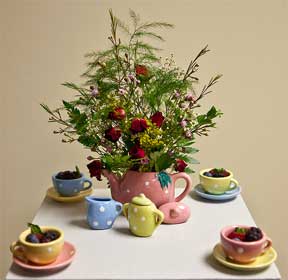Much of the fun in arranging flowers comes from having the right container.
Containers actually speak to the designer, suggesting a direction, a period, a setting, a textural combination, a color combination or a mood. A bright yellow cookie jar would surely say a bright happy bouquet of daisies, a casual arrangement of marigolds or some bright, less formal flowers, more carelessly placed.
For the inexperienced flower arranger it is well to start with a few good basic containers instead of many nondescript receptacles that merely hold water. Choose the period that will look well in your home and in colors that will blend with the color scheme. Usually dull greens, dark blues and warm browns will blend into many surroundings. You may also want a black or white depending on your taste and requirements.

A pillow vase, a shallow oblong or rectangular container, a compote or footed piece, a round bowl in two or more sizes and colors, are shapes that are basic.
Unless the arrangement will be placed in an extremely small room, choose large or medium size containers, especially if you are just beginning to arrange flowers. Trying to design in a small container is like the artist trying to paint a landscape on a tiny ten by ten inch canvas. It surely will retard your free use of material.
We should remember that the flowers are the subject matter of the design and make the container support them but not take over the show. Decorated containers may be good for certain uses. go set a mood or accentuate the period, bill are not usually recommended for basic use. The little bowl decorated with pansies may be fine for holding pansies. but will look pretty awful filled with black-eyed-susans.
As we progress in the art of flower arranging the word texture takes on more and more meaning. We may rediscover the sense of touch. It is not just the satin of the rose or the crispness of sweet peas that attracts us but the roughness of driftwood and the prickliness of cactus. We come to seek contrast between floral material and the container as a means of obtaining dominance and unity.
We see materials used in making flower containers, such as copper, pewter, silver, porcelain, pottery, wood and glass. We have said many times, if we could have only one container to use for all flowers and for all occasions we would choose copper or pewter, assuming of course that it has good shape. Either is fine enough for roses and coarse enough for sunflowers.
Satisfying as it is to own a fine piece of porcelain, silver or glass, it is not necessary always to spend a large sum for flower containers. Old objects or utensils… maybe damaged… can sometimes be found at county fairs or antique shops and used satisfactorily. Such items may give us a chance to use our imaginations go refinish, resurface or reshape them into a very desirable piece.
